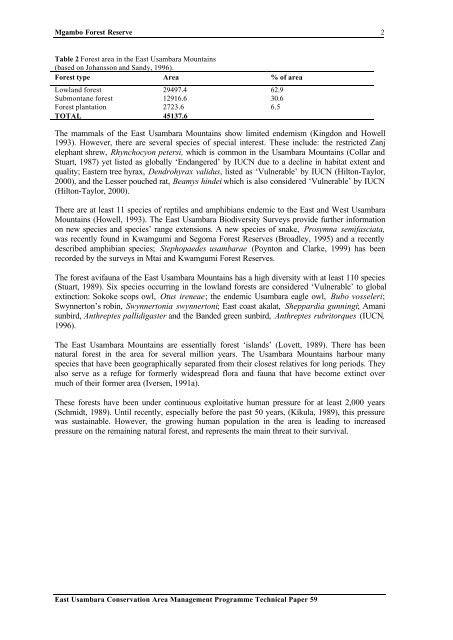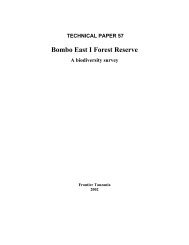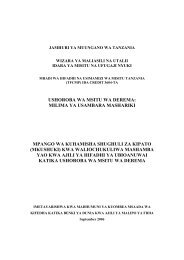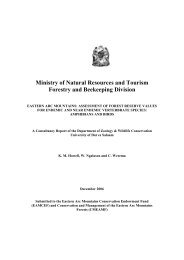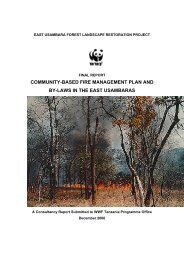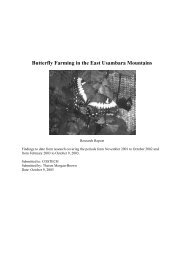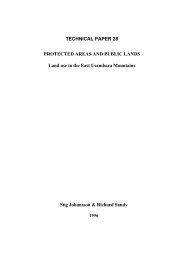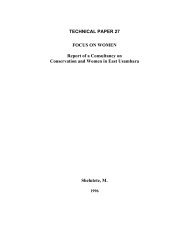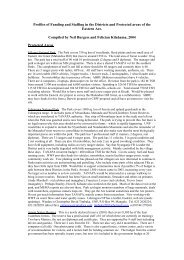Mgambo Forest Reserve: A biodiversity survey. - Eastern Arc ...
Mgambo Forest Reserve: A biodiversity survey. - Eastern Arc ...
Mgambo Forest Reserve: A biodiversity survey. - Eastern Arc ...
You also want an ePaper? Increase the reach of your titles
YUMPU automatically turns print PDFs into web optimized ePapers that Google loves.
<strong>Mgambo</strong> <strong>Forest</strong> <strong>Reserve</strong><br />
Table 2 <strong>Forest</strong> area in the East Usambara Mountains<br />
(based on Johansson and Sandy, 1996).<br />
<strong>Forest</strong> type Area % of area<br />
Lowland forest 29497.4 62.9<br />
Submontane forest 12916.6 30.6<br />
<strong>Forest</strong> plantation 2723.6 6.5<br />
TOTAL 45137.6<br />
The mammals of the East Usambara Mountains show limited endemism (Kingdon and Howell<br />
1993). However, there are several species of special interest. These include: the restricted Zanj<br />
elephant shrew, Rhynchocyon petersi, which is common in the Usambara Mountains (Collar and<br />
Stuart, 1987) yet listed as globally ‘Endangered’ by IUCN due to a decline in habitat extent and<br />
quality; <strong>Eastern</strong> tree hyrax, Dendrohyrax validus, listed as ‘Vulnerable’ by IUCN (Hilton-Taylor,<br />
2000), and the Lesser pouched rat, Beamys hindei which is also considered ‘Vulnerable’ by IUCN<br />
(Hilton-Taylor, 2000).<br />
There are at least 11 species of reptiles and amphibians endemic to the East and West Usambara<br />
Mountains (Howell, 1993). The East Usambara Biodiversity Surveys provide further information<br />
on new species and species’ range extensions. A new species of snake, Prosymna semifasciata,<br />
was recently found in Kwamgumi and Segoma <strong>Forest</strong> <strong>Reserve</strong>s (Broadley, 1995) and a recently<br />
described amphibian species; Stephopaedes usambarae (Poynton and Clarke, 1999) has been<br />
recorded by the <strong>survey</strong>s in Mtai and Kwamgumi <strong>Forest</strong> <strong>Reserve</strong>s.<br />
The forest avifauna of the East Usambara Mountains has a high diversity with at least 110 species<br />
(Stuart, 1989). Six species occurring in the lowland forests are considered ‘Vulnerable’ to global<br />
extinction: Sokoke scops owl, Otus ireneae; the endemic Usambara eagle owl, Bubo vosseleri;<br />
Swynnerton’s robin, Swynnertonia swynnertoni; East coast akalat, Sheppardia gunningi; Amani<br />
sunbird, Anthreptes pallidigaster and the Banded green sunbird, Anthreptes rubritorques (IUCN,<br />
1996).<br />
The East Usambara Mountains are essentially forest ‘islands’ (Lovett, 1989). There has been<br />
natural forest in the area for several million years. The Usambara Mountains harbour many<br />
species that have been geographically separated from their closest relatives for long periods. They<br />
also serve as a refuge for formerly widespread flora and fauna that have become extinct over<br />
much of their former area (Iversen, 1991a).<br />
These forests have been under continuous exploitative human pressure for at least 2,000 years<br />
(Schmidt, 1989). Until recently, especially before the past 50 years, (Kikula, 1989), this pressure<br />
was sustainable. However, the growing human population in the area is leading to increased<br />
pressure on the remaining natural forest, and represents the main threat to their survival.<br />
East Usambara Conservation Area Management Programme Technical Paper 59<br />
2


